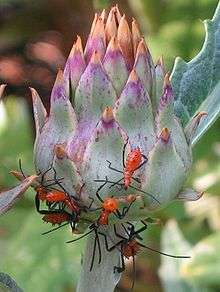Leptoglossus phyllopus
| Leptoglossus phyllopus | |
|---|---|
 | |
| Leptoglossus phyllopus on Pennisetum glaucum | |
| Scientific classification | |
| Kingdom: | Animalia |
| Phylum: | Arthropoda |
| Class: | Insecta |
| Order: | Hemiptera |
| Family: | Coreidae |
| Genus: | Leptoglossus |
| Species: | L. phyllopus |
| Binomial name | |
| Leptoglossus phyllopus (Linnaeus, 1767) | |
Leptoglossus phyllopus or Florida leaf-footed bug is a species of leaf-footed bug in the same genus as the western conifer seed bug (L. occidentalis) found throughout the southern United States from Florida to California, through Mexico and as far south as Costa Rica.[1]
These bugs are a common garden insect which may damage a wide variety of crops including cotton, peaches and tomatoes, and seeds such as beans, black-eyed peas and sorghum.[2] Like other bugs L. phyllopus suck juices from plants by puncturing them with their sucking mouth parts, making them resistant to ingested pesticides. A toxin is injected into the plant when piercing its skin, causing discoloration and hard spots on fruits.[3] The adult bugs are highly resistant to pesticides; however, they are vulnerable in their bright orange nymph stage. Trap crops can be used to lure them away from desired plants and to encourage predator populations,[4] and in small garden plots handpicking, the use of trap crops, and bug traps baited with methyl (E, Z)-2,4-decadienoate can be effective controls.[5]
This bug may enter houses when the weather turns colder and likes to make a home for itself in beds. In a wooded area, the bug will probably be found in homes. It sucks the sap from the cones of various coniferous trees. Pesticides will not get this bug out of a home, so the best means is hand removal. Also, to prevent the bug getting in, one can secure all window screens, attic vents, and other openings.
Acetosyringone is produced by the male leaffooted bug and used in its communication system.[6][7][8] Leptoglossus phyllopus emit a foul odor when handled[9]
References
- ↑ http://entnemdept.ufl.edu/creatures/orn/leaffooted_bug.htm
- ↑ https://insects.tamu.edu/fieldguide/aimg65.html
- ↑ http://aggie-horticulture.tamu.edu/galveston/weekly_Q&A/p&dc_12.htm
- ↑ http://nfrec.ifas.ufl.edu/mizellrf/stink_bugs/bug_trap_crops.htm
- ↑ http://edis.ifas.ufl.edu/in534
- ↑ Acetosyringone on www.pherobase.com, the pheromones data base
- ↑ Male specific natural products in the bug, Leptoglossus phyllopus: Chemistry and possible function. J.R. Aldrich, M.S. Blum, S.S. Duffey and H.M. Fales, Journal of Insect Physiology, Volume 22, Issue 9, 1976, Pages 1201-1206 doi:10.1016/0022-1910(76)90094-9
- ↑ Species-specific natural products of adult male leaf-footed bugs (Hemiptera: Heteroptera). J. R. Aldrich, M. S. Blum and H. M. Fales, Journal of Chemical Ecology, Volume 5, Number 1, 53-62, doi:10.1007/BF00987687
- ↑ https://insects.tamu.edu/fieldguide/aimg65.html
| Wikispecies has information related to: Leptoglossus phyllopus |
External links
- General information: http://insects.tamu.edu/fieldguide/aimg65.html
- leaffooted bug on the UF / IFAS Featured Creatures Web site
- Stink Bugs and Leaffooted Bugs Are Important Fruit, Nut, Seed and Vegetable Pests1 again from UF / IFAS
